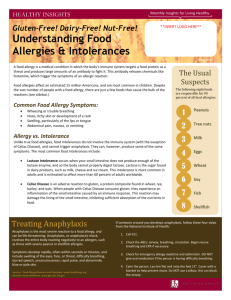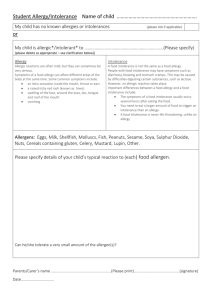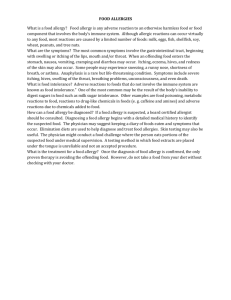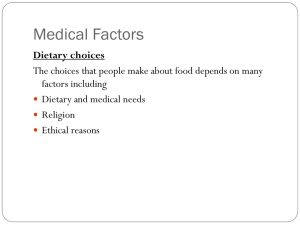Tips At Tech: Fun Facts Food Allergies Be Careful What You Eat
advertisement
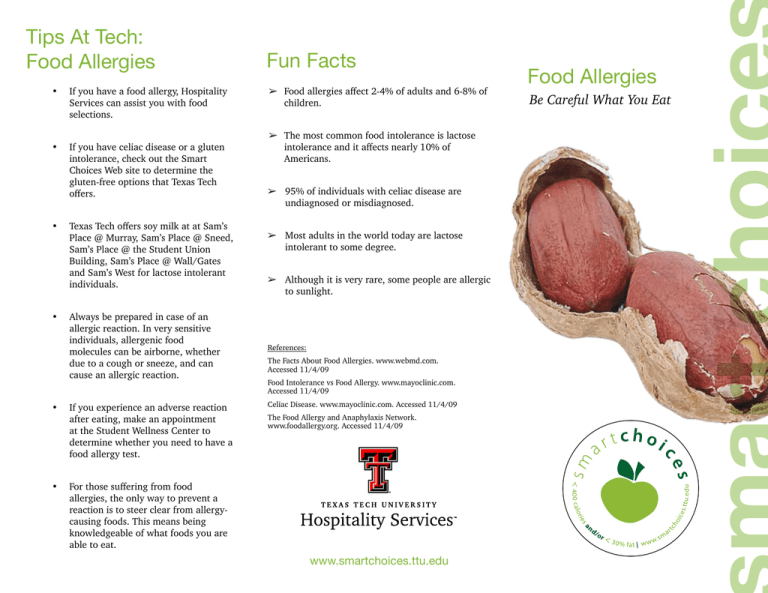
Tips At Tech: Food Allergies Fun Facts • If you have a food allergy, Hospitality Services can assist you with food selections. ➢ Food allergies affect 2-4% of adults and 6-8% of children. ➢ The most common food intolerance is lactose intolerance and it affects nearly 10% of Americans. • If you have celiac disease or a gluten intolerance, check out the Smart Choices Web site to determine the gluten-free options that Texas Tech offers. • Texas Tech offers soy milk at at Sam’s Place @ Murray, Sam’s Place @ Sneed, Sam’s Place @ the Student Union Building, Sam’s Place @ Wall/Gates and Sam’s West for lactose intolerant individuals. • Always be prepared in case of an allergic reaction. In very sensitive individuals, allergenic food molecules can be airborne, whether due to a cough or sneeze, and can cause an allergic reaction. ➢ 95% of individuals with celiac disease are undiagnosed or misdiagnosed. ➢ Most adults in the world today are lactose intolerant to some degree. ➢ Although it is very rare, some people are allergic to sunlight. References: The Facts About Food Allergies. www.webmd.com. Accessed 11/4/09 Food Intolerance vs Food Allergy. www.mayoclinic.com. Accessed 11/4/09 • If you experience an adverse reaction after eating, make an appointment at the Student Wellness Center to determine whether you need to have a food allergy test. Celiac Disease. www.mayoclinic.com. Accessed 11/4/09 • For those suffering from food allergies, the only way to prevent a reaction is to steer clear from allergycausing foods. This means being knowledgeable of what foods you are able to eat. The Food Allergy and Anaphylaxis Network. www.foodallergy.org. Accessed 11/4/09 www.smartchoices.ttu.edu Food Allergies Be Careful What You Eat Food Allergies A food allergy is actually an immune response to a food, or a specific protein in food, that the body mistakenly believes to be harmful. Individuals can be allergic to any food, but there are eight foods that account for approximately 90% of all reported allergic reactions to food. These eight foods are: milk, egg, peanut, tree nuts (walnuts and almonds), fish, shellfish, soy, and wheat. Even a tiny amount of an allergy-causing food can trigger reactions such as digestive problems, hives, or swollen airways. In some individuals, exposure to specific foods can cause severe symptoms or a life-threatening reaction known as anaphylaxis. Anaphylaxis is a serious allergic reaction that is rapid in onset and may lead to death. Symptoms of Food Allergies Not all food allergies are severe, and in some people they may only cause mild discomfort. Since allergic reactions usually develop within a few minutes to an hour after eating a particular food, most people are aware of which foods they are allergic to. The most common symptoms are: · Tingling of the mouth · Itching, hives, and rashes · Swelling of lips and face · Trouble breathing · Vomiting and diarrhea Food Allergy vs Food Intolerance Common Food Intolerances Just because you have an adverse reaction to a food does not always mean you are allergic. Most of these reactions are caused by a food intolerance, which is much more common. The two are easily confused because they share many of the same signs and symptoms. Unlike a food allergy, an intolerance does not involve the immune system. Several food intolerance conditions that are often mistaken for allergies include: • Irritable bowel syndrome (IBS) • Food poisoning • Sensitivity to food additives • Stress or psychological factors • Celiac disease Gluten Intolerance Gluten is the protein found in wheat, rye, and barley. It is found in most of the grain based products we eat, such as bread, cereals, pasta, and baked goods. Individuals that experience abdominal pain, gas, and diarrhea after eating products containing gluten, most likely have a gluten intolerance. For individuals with celiac disease, or an allergy to gluten, eating gluten-containing foods is much more harmful and can result in damage to the small intestine. If you experience gas, bloating, abdominal pain, or diarrhea after eating glutencontaining foods, check with your doctor to get tested for celiac disease. • Absence of a necessary enzyme (as seen in individuals with lactose intolerance) Lactose intolerance simply means that you have a lactase deficiency. Lactase is the enzyme necessary to digest lactose, or the main sugar in dairy products. This usually results in symptoms such as bloating, gas, and diarrhea. The condition is not dangerous, but it can be very uncomfortable. It’s important to determine whether you have a food intolerance or a food allergy. If you have a food intolerance, you may be able to still eat small amounts of those particular foods without adverse reactions, but with a food allergy, a small amount could be deadly. If you have a reaction to a particular food, talk to your doctor to determine whether you have a true food allergy. If you do have a food allergy, you will need to be careful to avoid allergy-causing foods and be prepared to respond to an allergic reaction. www.smartchoices.ttu.edu Lactose Intolerance To control the symptoms of lactose intolerance, choose lactose free milk, calcium fortified soy, rice, or almond milk.
